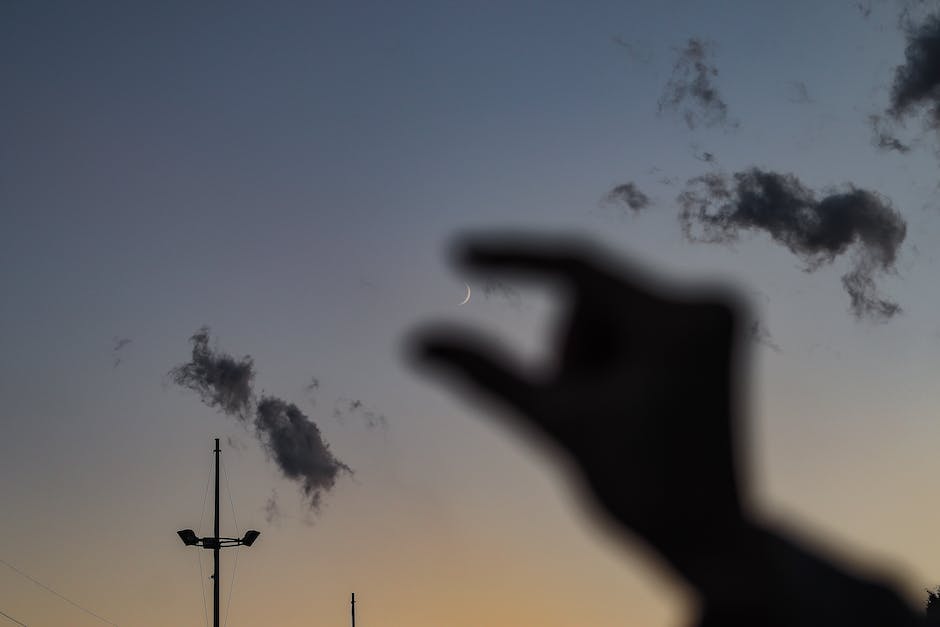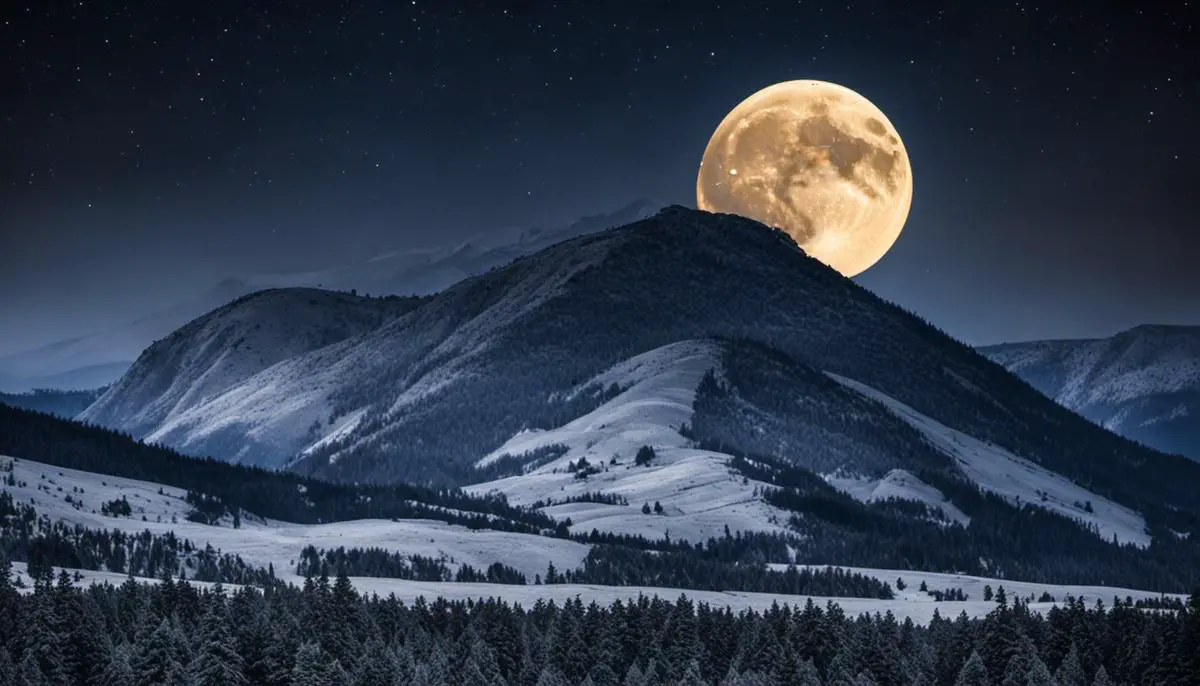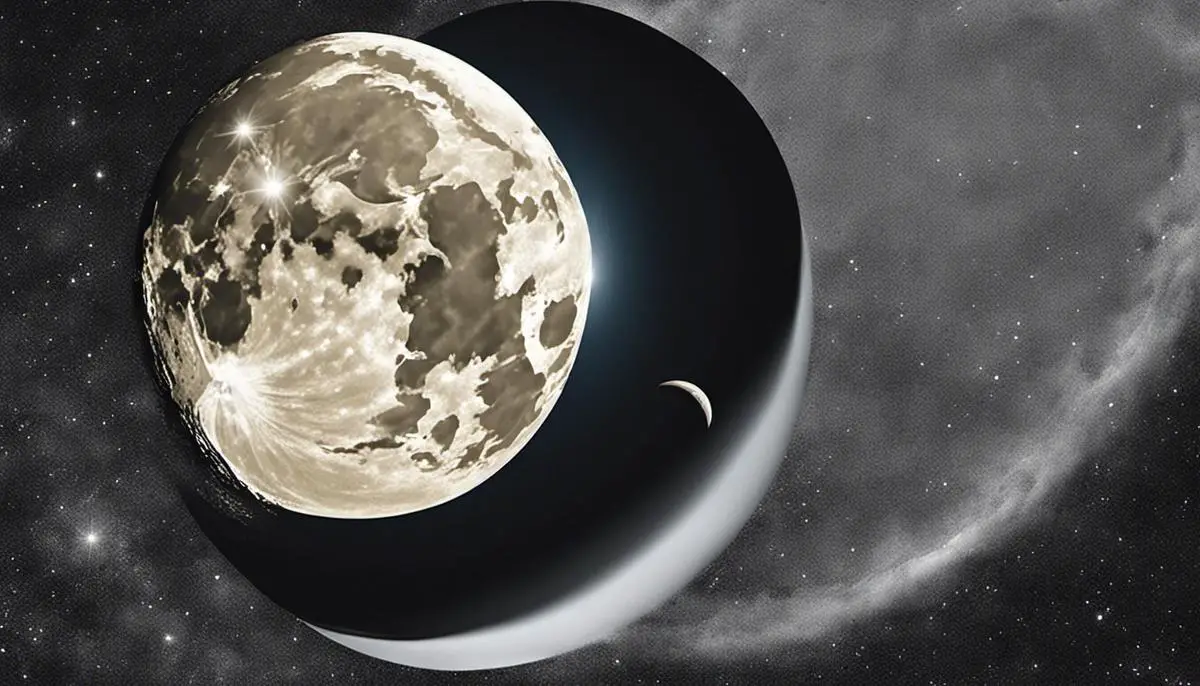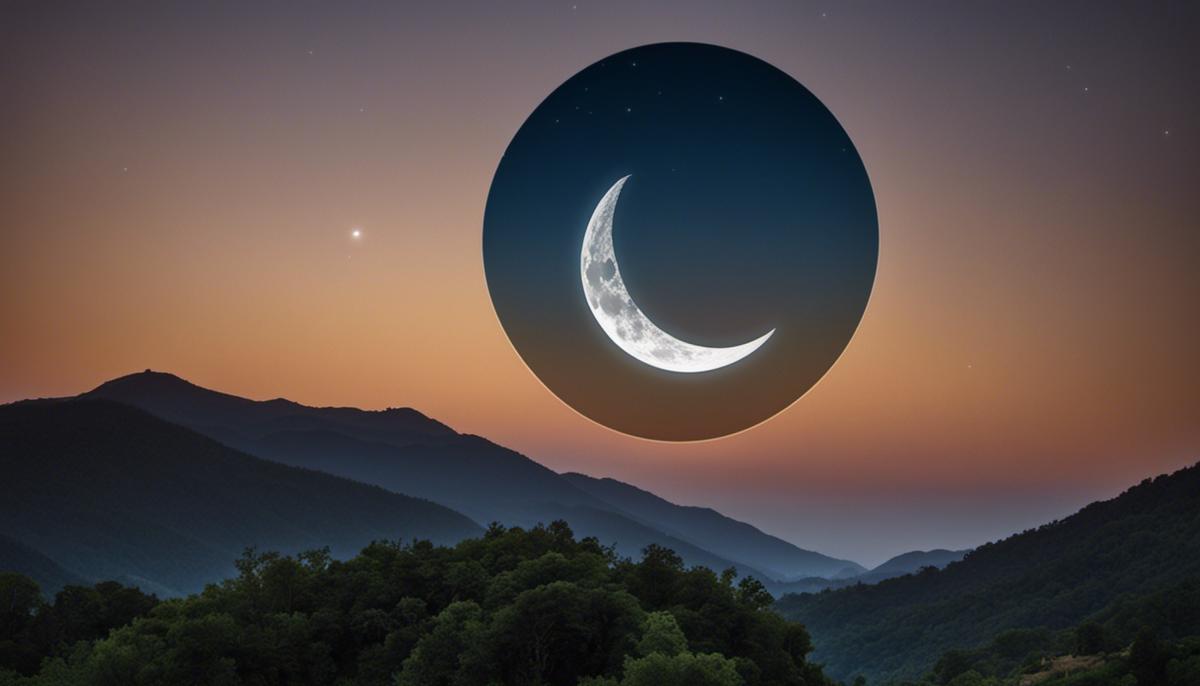Every so often, when the moon hangs low in the sky, gazing at it can create a fascinating illusion, where it appears to be enormous and within arms’ reach—an illusion phenomenon commonly referred to as the ‘finger moon’. This occurrence marries science with art, photography, culture, and literature. In this exploration, we delve into the heart of the phenomenon to understand its scientific basis and optical illusion, capture its elusive beauty through photography, appreciate its role in culture, art, and literature, and even revisit the latest scientific studies conducted on this peculiar yet captivating spectacle.
Understanding the Finger Moon Phenomenon
Understanding the Finger Moon Phenomenon
The Finger Moon phenomenon is an interesting celestial spectacle often observed by skywatchers and casual observers alike. Essentially, it is an optical illusion wherein the Moon appears small when it is high in the sky but seems increasingly larger as it nears the horizon. This scenario is what gives rise to the name as one tends to perceive that they could reach or ‘touch’ the moon with their fingers during the course of this phenomenon.
Scientific Basis Behind Finger Moon Phenomenon
Scientifically, this phenomenon attributes itself to the ‘Moon illusion’, a term derived to explain the Moon’s larger-than-usual appearance when it is observed near the horizon. In reality, the Moon’s size remains unchanged, no matter where it’s positioned in the sky. Its distance from Earth does not have as significant an effect as you might think, and any variance in size one perceives is largely the result of your brain trying to adjust to different reference points visible in your environment.
When the Moon is near the horizon, it appears large primarily because there are more objects – like buildings, trees, or mountains – to provide a reference for scale. Conversely, when the Moon is high in the sky, the lack of a surrounding context removes the framework for the brain to compare distances, causing the Moon’s size to be perceived as smaller.
Optical Illusion and Perspective Role
The complex interaction between our brain and optical inputs significantly contributes to the Finger Moon or Moon illusion. Our eyes take in the visual information provided by our surroundings, sending it to our brain, which then interprets it to create our perception of the world. Consequently, the perceptual discrepancies result in the Moon’s perceived change in size. This is a prime example of how our understanding of distance, size, and perspective can often be influenced by illusions.
This perspective effect is enhanced when the Moon is full and bright, presenting a striking contrast against its surroundings, which is why the Finger Moon phenomenon may seem exaggerated during full moon nights.
Understanding the Phenomenon of Finger Moon
The Finger Moon event manifests the incredible way our human brain perceives and courses through the world. Its influence isn’t merely confined to the observation of celestial entities, but rather extends to numerous areas of life – from arts and architecture, aviation, to even virtual reality technologies. Learning about this phenomenon isn’t solely about space or moon, but it offers valuable enlightenment about our brain, perception, and the intricate relationship with our sensory system.
Remember, when you next see the Moon close to the horizon, seemingly large enough to grasp within your hands, it’s not just a sight to behold. Instead, it’s your brain fashioning that breathtaking spectacle. It’s an indication that our perception can quite often warp reality, generating mesmerizing illusions and spectacles for our enjoyment.

Cultural Reflections of Finger Moon
Cultural Significance of Finger Moon
Known by various names worldwide such as the crescent moon or thumbnail moon, the finger moon holds profound symbolism across cultures owing to its regular appearances in the nocturnal canvas. For instance, in Islamic traditions, spotting the crescent moon or finger moon conventionally denotes the commencement of each month according to the Islamic lunar calendar. Its significance magnifies during the holy month of Ramadan, where the initial sighting of the crescent moon marks the outset of fasting.
Looking at Chinese culture, the finger moon or crescent moon typically represents renewal and the feminine Yin principle. It signifies the cycling stages of life and death, growth and decay, aligning itself with the broader theme of balance and change crucial to Taoist philosophy.
Folklore and Historical References of Finger Moon
In Native American cultures, many tribes contain legends about the finger moon. A popular belief among the Navajo, Pawnee, and Ojibwe tribes is that the crescent moon is a guide for hunters and crops, signalling when certain game would be abundant or when it would be an ideal time to plant crops.
Historically, in ancient Rome, the lunar deity known as Diana was often depicted with a crescent moon or a finger moon resting above her forehead, emphasizing her control over the moonlight and the hunt.
Celtic cultures believed that the finger moon was closely tied to the otherworld or spiritual realm. It brought in the energies necessary for magick and served as a bridge between the earthly and ethereal planes.
Local Beliefs Associated with Finger Moon
In numerous African cultures, the appearance of the finger moon is always an event of great significance. For the Zulu and Shona tribes, a crescent moon signals the time for ceremonial dances and rites to invoke ancestral spirits for protection, good luck, and abundant harvests.
In some Indian traditions, the sighting of a finger moon on particular days bears auspicious meanings. It is a common practice to sight and worship the crescent moon after the new moon day, also known as Amavasya. Commonly, it is believed to bring prosperity and good fortune.
The crescent or finger moon, despite its small size, holds a powerful presence in the night sky. Across different cultures, it carries various meanings, but universally the finger moon symbolizes cycles of growth, renewal, and celestial guidance. The ability of this moon phase to captivate people around the world is a remarkable testament to the enduring human fascination with the mysteries of the moon and its various phases.

Photographing the Finger Moon
Delving Deeper into the Phenomenon of the Finger Moon
Often caught in the lens of both professional and amateur photographers, the finger moon invites intrigue and wonder due to its unique visual appeal. This phase of the moon, characterized by its slender, arc-like shape resembling a bent finger, occurs during the waxing or waning stages of the moon’s monthly lunar cycle. The beguiling aesthetics of the finger moon, coupled with our inherent curiosity, continues to make it a subject of wonder and exploration.
Best Conditions for Capturing the Finger Moon
Optimal conditions for photographing the finger moon include clear skies, as clouds can obscure the moon and reduce the sharpness and detail in your photos. Ideally, the moon should also be relatively high in the sky, away from horizon-based atmospheric distortions. Light pollution, such as sodium or mercury vapor street lights, is another factor to consider; avoid such pollution for the clearest shots.
Recommended Camera Settings
Shoot in manual mode to have full control over the exposure. The “Looney 11” rule offers a starting point: set your aperture to f/11, then match the ISO with the shutter speed. If you’re shooting with ISO 100, set the shutter speed to 1/100th of a second. For close-ups, a telephoto lens with a focal length of at least 200mm is recommended. Finally, RAW format is preferable as it gives more flexibility in post-processing.
Best Times and Locations to Photograph the Finger Moon
The best times for photographing the moon are during the golden hour (just after sunset or just before sunrise), when the light is soft and diffused, or during a moonrise or moonset. The location should ideally have minimal light pollution, like rural areas or elevated locations such as hills or observatories.
Additional Photography Tips for Finger Moon Shots
A sturdy tripod is essential to stabilize your camera, preventing blur from camera movement. Using a remote shutter release or your camera’s self-timer mode can also help to minimize camera shake. Including foreground elements, like trees or buildings, can add depth and a sense of scale to your lunar photography. Finally, patience and willingness to experiment are vital. Try different settings and compositions, and be prepared to take many shots – the results can be rewarding.
Enhancing Finger Moon Photography through Post-Processing
With the power of post-processing software such as Adobe Lightroom, your finger moon photos can reach new levels of brilliance. Subtle refinements, like increasing contrast, enhancing clarity, and sharpening the image, can really make the moon’s surface details come alive. Features such as cropping can assist in composing the perfect shot, while noise reduction can lessen graininess from high ISO settings. However, strive to maintain a realistic appearance and avoid excessive adjustments.

The Finger Moon in Art and Literature
Artistic Representations of the Finger Moon
In the realm of art, various illustrious artists have depicted the Finger Moon, making it a prominent symbol in their creations. Renowned artist Vincent Van Gogh subtly incorporated a small crescent Finger Moon into his masterpiece “Starry Night,” elegantly positioned amongst the vibrant swirls of the painting. Meanwhile, Marc Chagall’s “Over the Town” aptly features a full finger moon hanging overhead. These painters captured more than just the physical image of the Finger Moon; they encapsulated its enchanting allure. Beyond its visual appeal, the Finger Moon often carries profound symbolic connotations across different cultures and eras.
Understanding the Finger Moon in Legendary Literature
Finger Moon is not solely confined to visual art. Its impact also transcends into literature. Authors and poets, over centuries, have utilized its powerful imagery to explore multitude themes including love, despair, mystery, hope, and renewal. Notably, Robert Louis Stevenson in his poetry “The Moon” described the moon as “She shines on thieves on the garden wall/On streets deserted by/She sighs a sigh for the merry children/That laugh the sleep away”. The use of the Finger Moon in his verse symbolizes the passage of time and often marks the start of a plot change.
Finger Moon through the Lens of Poetry
In poetry, the Finger Moon often stands at the intersection of the terrestrial and celestial realms, harmonizing the earthly experiences with the cosmic order. Emily Dickinson’s fondness for the moon can be traced in the breadth of her work. In her short poem, she refers to the moon, “I see a brightness in the sky, a luster in the air, the cheek of the moon!” Here, the Finger Moon is represented as an empathetic companion to the poet, shining her soothing light through the darkness.
Interpretation of Finger Moon
Artists and writers have often used the Finger Moon as a symbol to interpret different human emotions, experiences and perceptions. In many cultures, the Finger Moon represents growth and progression, inciting artists to incorporate it as metaphorical symbolism. Others find it as a sign of secrecy and subtle revelations, marking the commencement or end of love, adventure and other human pursuits.
The Significance of Finger Moon through the Lens of Art and Literature
In the realms of art and literature, the Finger Moon has been portrayed in multifarious ways, shaping our perception of this lunar wonder. Its portrayals range from symbolizing mystical constructs, functioning as a metaphorical cornerstone, to mirroring tangible realities. Furthermore, these creative expressions have fostered a more profound respect for the Finger Moon, elevating its status from a mere astronomical object to an influential cultural entity.

Scientific Studie and Research on Finger Moon
An In-Depth Analysis of the Finger Moon Phenomenon
Renowned in both the fields of astronomy and astrology, the Finger Moon phenomenon introduces a novel sphere of research. The phenomenon, commonly known as “Finger Moon,” is associated with the visual image of the crescent moon appearing as though it could be ‘pinched’ using one’s thumb and forefinger. This fascinating concept has significantly expanded the scope of lunar studies.
Latest Scientific Studies on Finger Moon
Recent scientific studies on the Finger Moon phenomenon have shed light on various aspects of the concept. Research has primarily centered on understanding the moon’s positioning, its light distribution, and the visual perceptions related to it. Also, there is a growing interest in understanding any potential astrological impacts it could have on humans and the Earth.
Astrophysical Insights from Finger Moon Studies
Scientific studies on the Finger Moon phenomenon include the exploration of Earth-Moon-Sun relationships and lunar phases. This unusual perspective on the moon is primarily found when our celestial neighbor is at a specific point in its orbit around the Earth. It has served to offer insights into the role of observational points and angles in our understanding and interpretation of celestial objects.
The Optical Illusion Aspect
The idea of the Finger Moon has also played a significant role in understanding visual perceptions and psychological aspects related to celestial observations. Some research suggests that the Finger Moon phenomenon is largely an optical illusion. The difference in size and proximity between the Moon and the human finger, coupled with the distance between the human observer and the celestial objects, generates this illusion of being able to ‘hold’ the moon between fingers.
Ongoing Research in the Field
Ongoing research is focusing on the complex interplay between astronomy, optics, psychology, and human perception, primarily using the Finger Moon phenomenon as the basis. These studies aim to clear misconceptions and provide a deeper scientific understanding of the lunar cycle, celestial object observation, and relative positions of objects in space.
In the future, research on the Finger Moon could provide more insight into visual perception, distance calibration, and astrological interpretations. By continuing this line of inquiry, scientists and researchers hope to further demystify the cosmos, enhance comprehension of celestial phenomena, and utilize this information in pragmatic, real-world applications.

Although the finger moon appears as nothing more than an optical illusion, it holds profound significance that traverses beyond the realms of science. It has profound cultural reflections embedded in folklore and local beliefs. Artists, poets and authors, infuse their interpretations creating immortal impressions of this celestial phenomenon. Even as photographic enthusiasts continuously aim to encapsulate its elusive beauty, researchers tirelessly engage in expanding our knowledge and understanding of the finger moon. And so, our connection with this moon continues to grow, reminding us of the magic that lies in our night sky and how it continues to be a source of fascination across an assortment of fields.
![]()
